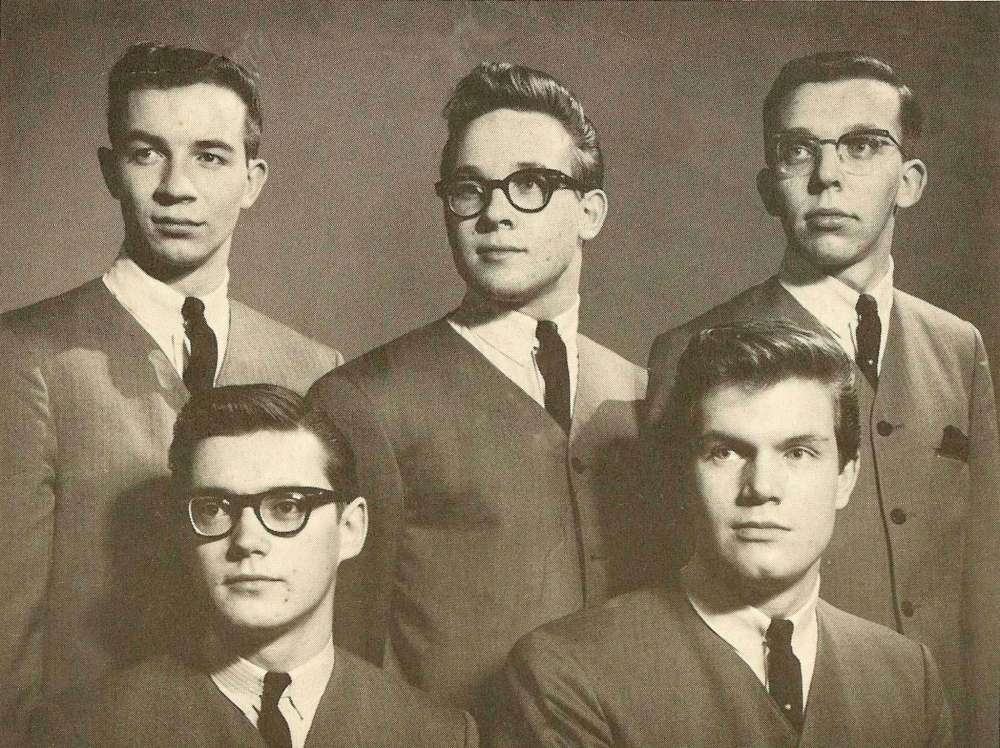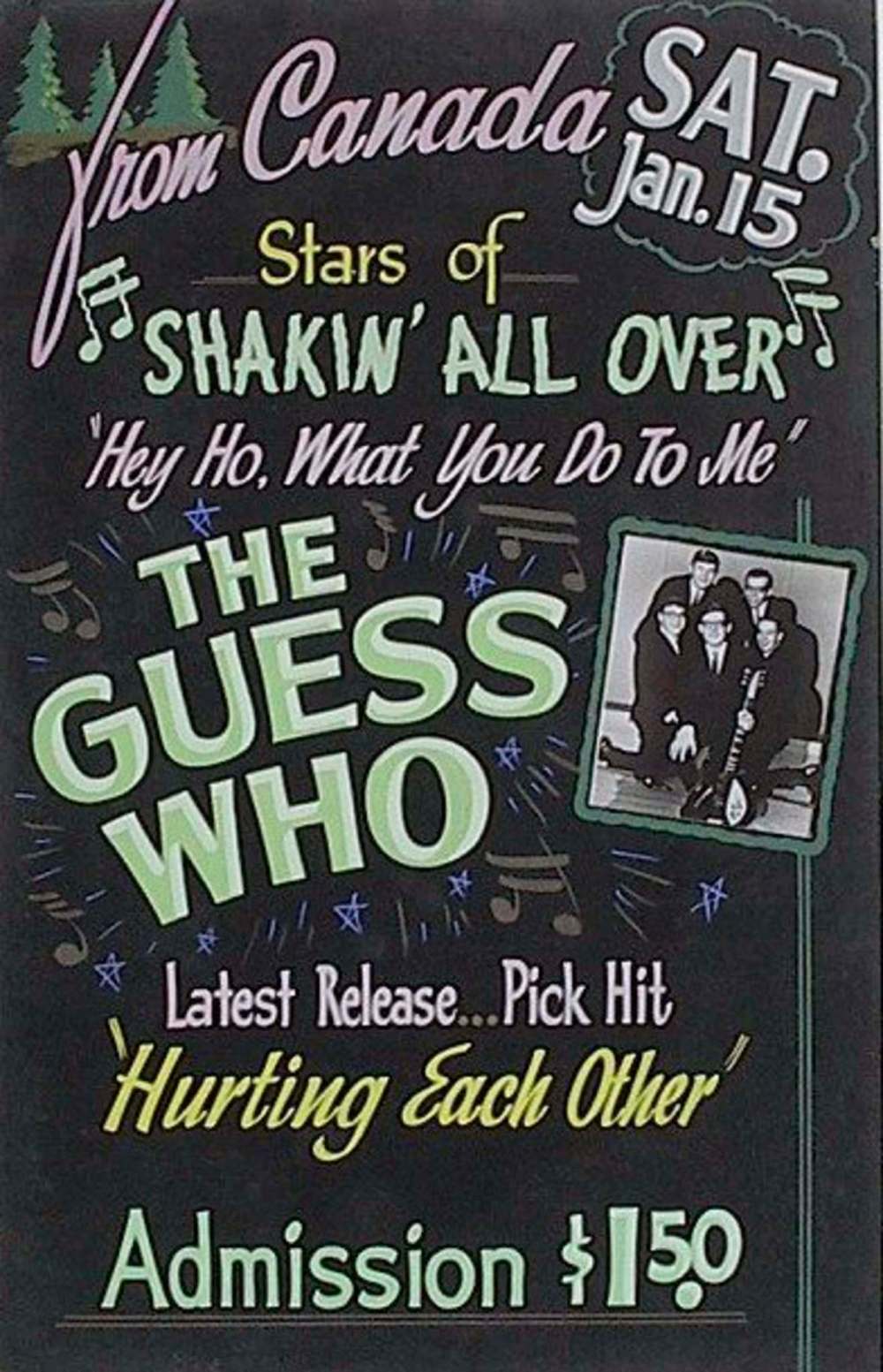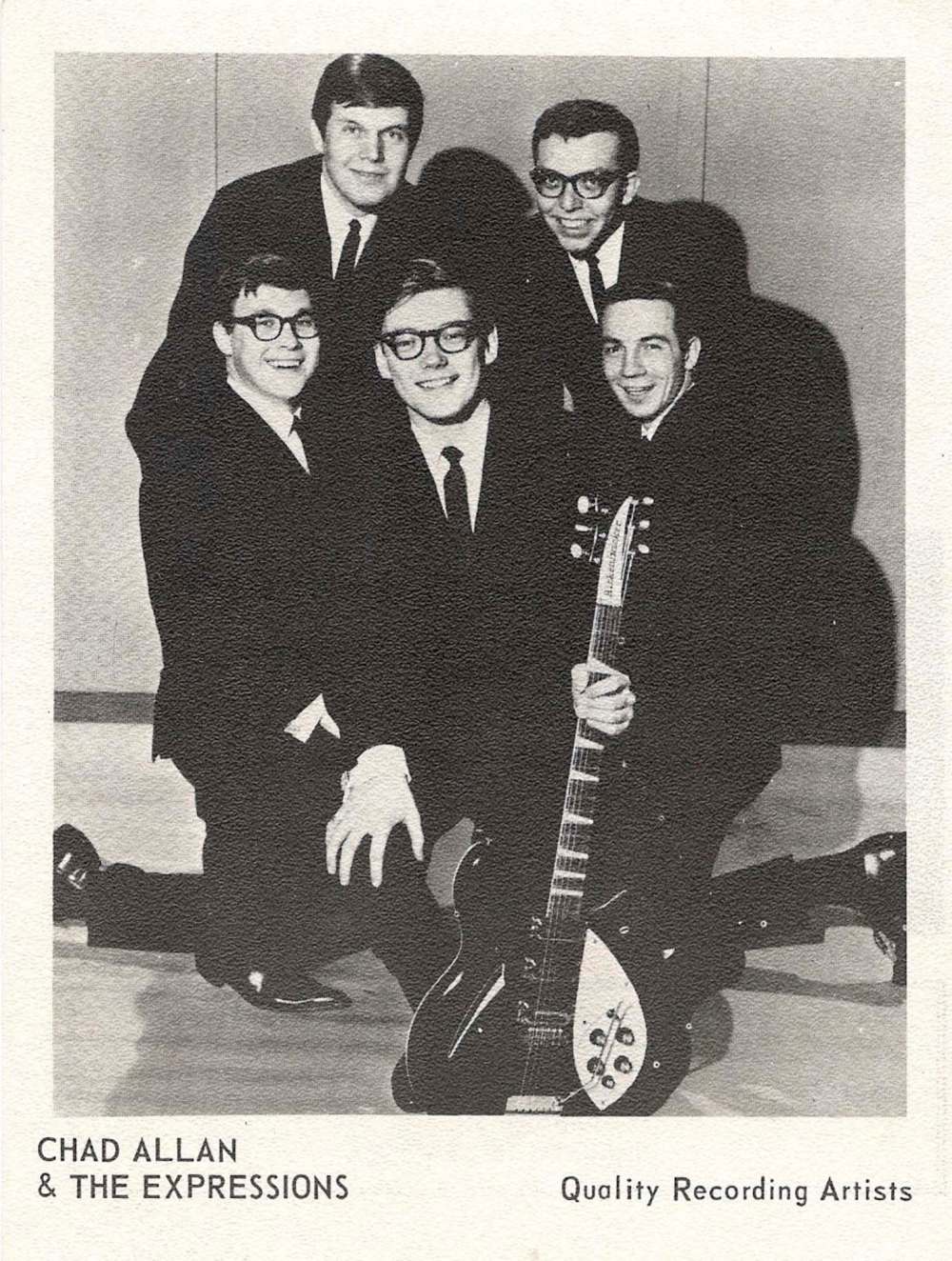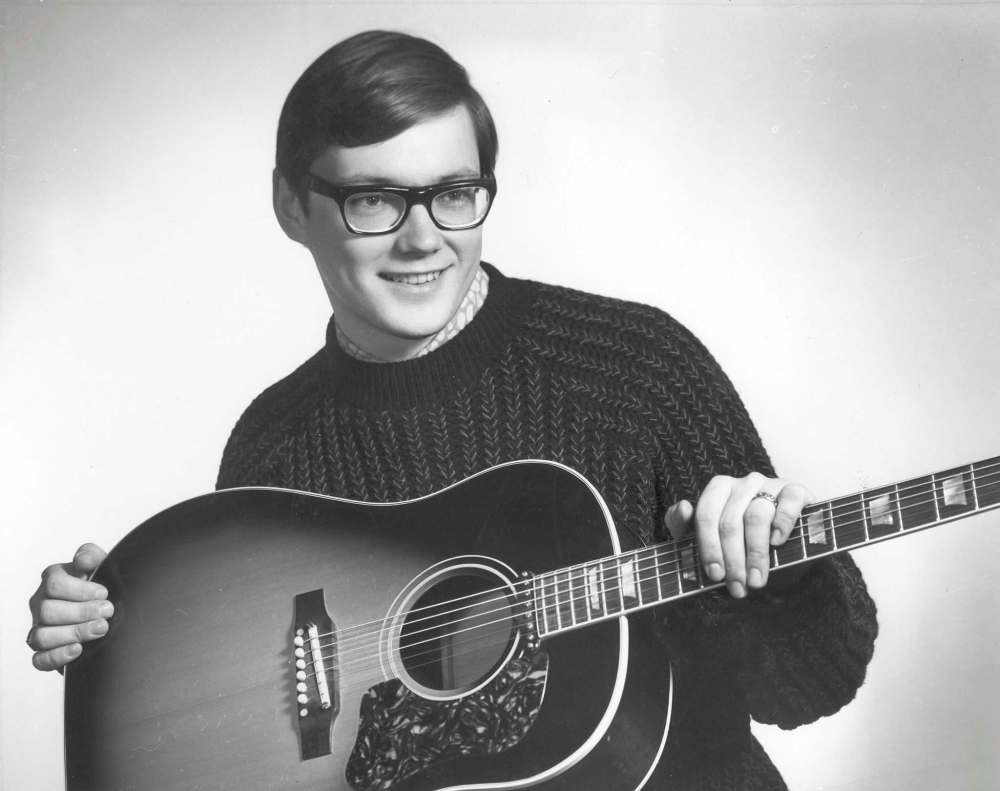Record company’s gimmick launched Guess Who’s career
Advertisement
Read this article for free:
or
Already have an account? Log in here »
To continue reading, please subscribe:
Monthly Digital Subscription
$0 for the first 4 weeks*
- Enjoy unlimited reading on winnipegfreepress.com
- Read the E-Edition, our digital replica newspaper
- Access News Break, our award-winning app
- Play interactive puzzles
*No charge for 4 weeks then price increases to the regular rate of $19.00 plus GST every four weeks. Offer available to new and qualified returning subscribers only. Cancel any time.
Monthly Digital Subscription
$4.75/week*
- Enjoy unlimited reading on winnipegfreepress.com
- Read the E-Edition, our digital replica newspaper
- Access News Break, our award-winning app
- Play interactive puzzles
*Billed as $19 plus GST every four weeks. Cancel any time.
To continue reading, please subscribe:
Add Free Press access to your Brandon Sun subscription for only an additional
$1 for the first 4 weeks*
*Your next subscription payment will increase by $1.00 and you will be charged $16.99 plus GST for four weeks. After four weeks, your payment will increase to $23.99 plus GST every four weeks.
Read unlimited articles for free today:
or
Already have an account? Log in here »
Hey there, time traveller!
This article was published 22/01/2017 (3237 days ago), so information in it may no longer be current.
Fifty-two years ago last week, on Jan. 16, 1965, the record that put Winnipeg on the national music map was released.
Quality Records, headquartered in Toronto, sent out radio-play copies across the country of a 45-rpm single mysteriously credited simply to Guess Who? With everything British dominating both the pop charts and the collective consciousness of teens, it was nearly impossible for homegrown recording artists to gain national airplay on radio stations. Regulations that mandated radio play 30 per cent Canadian content (now 35 per cent) were six years away. Quality Records decided to hoodwink radio programmers into giving this curiously labelled record a spin, gambling on the fact the distinct British style and infectious sound of the 45, along with the ambiguous identity, would pique interest.
The ruse worked. Within weeks, Shakin’ All Over was charting coast to coast, and by March it was either No. 1 or in the top 5 on every major radio station nationally. It was then that the mystery was revealed. Guess Who? was none other than Winnipeg quintet Chad Allan & the Expressions. Suddenly, Winnipeg became the rock ’n’ roll capital of Canada. What’s more, the single broke down the regional barriers that had prevented Canadian recording artists from achieving cross-country success.
‘To this day, I believe if it hadn’t been for the secrecy about who we were, possibly things wouldn’t have been the same’ — Chad Allan

“The importance of Shakin’ All Over cannot be overestimated for the Canadian pop music landscape of early 1965,” states writer/broadcaster Bob Mersereau, author of The Top 100 Canadian Singles and A History of Canadian Rock ’n’ Roll. “There had been plenty of regional hits from local artists that made the charts in different corners of the country, local artists that got the kids in say, Vancouver or Halifax all excited. But a national Canadian-made smash was a rare beast. National No. 1s were reserved for the Beatles, and after them came a dozen more British Invasion artists. With no Canadian-content regulations in place for radio, no decent recording studios and little incentive for big record labels to promote anything but the proven sellers, regional acts barely had a prayer. But before programmers knew it, they’d been tricked into giving the mystery band an even playing field. Then the kids took over, loving the song and making it a No. 1 hit in several markets.”
What is further astonishing about the success of Shakin’ All Over is it was not the intended hit. It was the B-side, or flip side, of Quality Records single 1691X. The recording of the song that remains the soundtrack to Winnipeg’s exciting 1960s music scene is a fascinating story, the stuff of legends.
Chad Allan & the Reflections — Chad Allan (Allan Kowbel) on guitar and vocals, bass player Jim Kale, Bob Ashley on keyboards, lead guitarist Randy Bachman and drummer Garry Peterson — had been together since 1962 and, by 1964, were the top rock ’n’ roll band in the city. A major draw on the community-club circuit, the group had also toured Western Canada and released three singles. But when Detroit group the Reflections scored a North American hit with Just Like Romeo and Juliet, Allan and the boys had to find a new name. Their fourth single, the very Beatles-sounding Stop Teasing Me — a Randy Bachman composition recorded in the summer of 1964 at Minneapolis’s Kay Bank Studios — was released under the name Chad Allan & the Original Reflections. Nonetheless, the Detroit combo had secured rights to the use of the Reflections name. Thus, our boys became Chad Allan & the Expressions. Close enough.

When it came time to record a new single in December 1964 (no one seems to recall the exact date), the band was reluctant to make the trek to Minneapolis in the dead of winter. Instead, manager and record producer Bob Burns, host of CJAY TV’s popular Teen Dance Party, suggested they record at the Polo Park television studio. Quick and cheap. As Bachman recalls, “It was against the station’s regulations to use the facility for private recording sessions, but Bob Burns went ahead and paid an engineer, a moonlighting CJAY employee, to come in. We set up in the Teen Dance Party set, a big concrete room with a large, black curtain used for background that helped deaden the cavernous concrete sound.”
The group had already decided what they would record that night. Allan’s East Kildonan buddy Wayne Russell had a cousin in the United Kingdom who sent him records that weren’t available in North America. That’s how Allan and the band were first introduced to the Beatles. Six months before the Fab Four’s groundbreaking appearance on The Ed Sullivan Show, Chad Allan & the Expressions were playing Beatles songs in their live shows. Russell’s cousin would also send him reel-to-reel audio tapes of the British hit parade.
“For rock ’n’ roll-crazed kids like us, it was like discovering buried treasure — songs you never ever heard in Winnipeg, A and B sides,” says Bachman. “We used to learn the songs right off the tapes, sometimes without knowing the title of the song.”

One such song was a cover of an Arthur Alexander record by Beatles contemporaries Gerry & the Pacemakers on a U.K.-only extended-play seven-inch record called Where Have You Been All My Life. American rhythm & blues singer Alexander was a favourite of U.K. bands. The Beatles had recorded his song Anna (Go to Him) and performed Soldier of Love and A Shot of Rhythm and Blues in their early live sets. The latter song was covered on the B-side of Chad Allan & the Original Reflections’ last single, gleaned from Gerry & the Pacemakers’ version on their debut album. The Rolling Stones covered Alexander’s ballad You Better Move On on their first EP.
The problem was Allan and the band didn’t know the title to Where Have You Been All My Life, so they took the first words, “Till we kissed,” as the title. They weren’t even sure it was an Alexander song, so they didn’t include a writing credit on the label.
The intended B-side for the recording session had a bit more history to it. In the summer of 1960, British rock ’n’ roll band Johnny Kidd & the Pirates scored a U.K. No. 1 hit with a song written by Frederick Heath (a.k.a. Johnny Kidd) called Shakin’ All Over. As Kidd later explained, “When I was going round with a bunch of lads and we happened to see a girl who was a real sizzler, we used to say that she gave us ‘quivers down the membranes.’ It was a standard saying with us referring to any attractive girl. I can honestly say that it was this more than anything that inspired me to write Shakin’ All Over.”
The recording featured guitarist Joe Moretti using a metal cigarette lighter on his strings to create the shivering chord sensation. Shakin’ All Over had a major impact on guitarists across the U.K., including the Who guitarist Pete Townshend, whose band recorded the song on their 1970 album Live At Leeds.
To say the Winnipeg recording session was spartan would be an understatement.
“There was just one microphone in the middle of the room,” Bachman explains, referring to the microphone used by Burns on the Teen Dance Party set, “and the entire band plugged into Jim Kale’s Fender Concert amp — all the instruments, two guitars, bass and piano. That was our mixing board. If we wanted to change the balance, we’d turn the channel volumes up or down. When we heard the first playback, the drums were too loud, so we left the mic where it was and moved the whole drum kit further back.”

The recording was done in mono with only one channel (as opposed to Kay Bank’s three-channel recording), with no overdubs and no stereo separation. What you heard live from the floor was what you got.
There were other challenges. “It was wintertime, Chad had a sore throat and we had played a dance earlier where he had sung for three hours, so his voice was totally gone,” says Bachman. “He was taking antihistamines and was so dizzy that he sang laying down flat on his back on the floor. We had to lean the mic over him. You can actually hear his raspy voice on the final recording.”
In fact, Allan’s circumstances resulted in his voice taking on a slight British tone. “I remember lying on a couch while the band was setting up for the recording because I wasn’t feeling well,” says Allan. “Then I got off the couch to sing, but I recall being nervous.”
The band had to work quickly. Till We Kissed, covered note for note from the Pacemakers rendition, required a couple of takes before getting it down in a final recording. Ashley’s piano playing dominated the track. Then came time for the B-side.
Because the Johnny Kidd & the Pirates recording had no piano on it, Ashley had to create a suitable part. “The original recording was pretty sparse-sounding, kind of primitive, so Bob filled in the sound by adding a clink-clink piano part,” says Allan.
Although Allan and Bachman had recently acquired trendy Rickenbacker guitars like the Beatles for the recording session, Bachman brought out his Gretsch 6120 Chet Atkins hollow-body guitar with a vibrato arm he used to create the shivering sound on the record.
(imagetag)
“It wasn’t set up as a normal studio,” adds Bachman, “because there weren’t any playback monitors. So we would have to record a take, put down our instruments, run into the little control room and listen to the playback on the tape recorder speakers. The engineer had to un-patch two plugs from the mic in the room and patch them into the speakers so we could hear a playback. He kept doing this, back and forth, and by this time it was 2:30 in the morning, and we were all very tired.”
On the fifth run-through, the engineer forgot to pull out the patch cords.
“When we went in to hear the playback it was feeding back into itself and had this slap-back echo on it — the instruments, drums, voice, everything. We heard it and yelled, ‘That’s like Elvis!’ It was like That’s All Right, Mama or Cliff Richard’s Move It. We told him, ‘Leave it, that’s the take!’ It was all totally by accident, but that was the sound on Shakin’ All Over.”
The next week, Burns sent the tapes to Quality Records in Toronto in anticipation of the single’s release early in the new year. In a 1983 interview, Quality Records’ George Struth explained what came next. “We had a master (tape) come in with a very strong British sound, which was what was happening at the time. To motivate sales, we pressed up a number of promotional records with just a white label on it, the title of the song and underneath it, ‘Guess Who’ with a question mark. We were endeavouring to motivate interest by not directly saying but implying that it was a master that we may have acquired from the British and it could have been the Beatles. But we didn’t say that, only implied it. Needless to say, after we sampled it, our phones lit up, and that’s how the name of the Guess Who came by chance.”
“There was an association there that seemed to stick that we were a heavy-duty American band or British band in particular,” recalls Allan, “and it seemed to me that we kind of passed that plateau before people had a chance to realize that we were a local band, and boom, it was a hit. People were supposed to guess who the band was. It wasn’t supposed to be our name, but it simply stuck.”
The plan had worked, but it was the B-side that generated the positive response. Once radio programmers and DJs heard Shakin’ All Over, there was no denying it was a hit. Till We Kissed was a non-starter. By March 22, Shakin’ All Over had reached the No. 1 spot on Toronto-based RPM’s national chart, knocking the Beatles’ Eight Days a Week from the top spot.

“When people across Canada heard the record, they thought it was a hybrid of one Beatle, one Rolling Stone, one Shadow, this kind of thing,” says Bachman. “Listeners actually phoned their stations claiming, ‘I know it’s one of the Rolling Stones.’ The record had a mystery surrounding it. Before we knew it, Shakin’ All Over was No. 1 in every region across the country, and people still didn’t know the identity of the group.”
In March, with the record high on charts across Canada, Struth phoned the band to inform them they had a new name: Guess Who? “We told him we hated it,” states Bachman.
For Allan, the new title came as a surprise.
“I was a little disappointed that my name was now deleted from the group’s name,” he admits, “but I did agree that we needed a better, more catchy, more internationally oriented name and appeal.”
Later pressings altered the label credit to read “Guess Who (Chad Allan & the Expressions),” while a few rare copies oddly credited the artist as Allan alone.
In their hometown, the band members were treated like celebrities wherever they went. The record had topped the charts here, and community-club engagements were packed to the rafters. An autograph session at Simpson-Sears turned into Beatlemania-style pandemonium as teens pushed and shoved one another for a chance to meet the local stars and get their autographs.
“People thought we were millionaires,” laughs Kale.
Overnight, Winnipeg became a music hot spot. “Winnipeg was the rock ’n’ roll capital of Canada as far as I was concerned,” Neil Young once declared.
Record labels came looking for the next Guess Who. The Jury, the Shondels, the Luvin’ Kind, the Fifth and the Eternals all landed national recording contracts with the big players, though none ever achieved anything remotely close to the Guess Who.
The success of the record in Canada allowed Struth to license it in other countries including Mexico, Britain, France and parts of Asia. New York-based Scepter Records, primarily a black music label owned by Florence Greenberg, optioned the record for American release. Scepter’s roster included the Shirelles, Chuck Jackson, B.J. Thomas and Dionne Warwick. Released in late spring, Shakin’ All Over was slow to catch on, breaking regionally in several markets, most notably in the northeastern U.S. after Boston’s WBZ radio got behind it. By June, the record had climbed to No. 22 on the Billboard chart in the U.S., an impressive feat for an unknown and unseen band.
“I remember going down to Kresge’s next to Eaton’s every Saturday morning, and the woman there had Billboard magazine,” says Bachman. “I would ask her where Shakin’ All Over was on the charts this week, and she’d say it was like No. 32 with a bullet. And I’d still be going off to school (Red River Community College) every Monday morning while our record was climbing the charts.” The record sold more than 200,000 copies in the U.S.

That June, the band travelled to New York to record tracks at Scepter’s studio for an American album (Quality Records in Canada had already released an album). They also toured the eastern U.S. in the company of artists such as the Kingsmen of Louie Louie fame, Sam the Sham & the Pharoahs, Dion & the Belmonts, the Turtles, the Shirelles and the Crystals. “We would do our set, take a break, then come out and back the Shirelles with Soldier Boy and all their hits — five white kids backing a trio of black girls. We didn’t know any better. The money was terrible, but that wasn’t the motivation for us. We played around New York, and it was great. Then we went to Chicago, and there was a riot going on right in front of us on the floor, black and white kids fighting. It was unbelievable. We didn’t have these kinds of problems in Canada.”
To capitalize on the single’s success, Scepter rushed out an album that featured a black couple dancing on the cover, leading to some ambiguity about the band. “We were booked to play in Washington, D.C.,” recalls Bachman. “We drove down from New York, went up to a high school, and it was a black high school. We got to the gate, and everyone was staring at us. We were scheduled to play an after-school sock hop. The principal came out and asked us what we were doing there. “We’re the Guess Who.” And he replied, “No, you’re not.” So we had to show him the Canadian album cover and he eventually let us in, but it was a very weird experience.”
Unfortunately, the band was unable to follow up the success of Shakin’ All Over in the U.S. In Canada, other singles charted well enough, but it would be four years before the band, by then known as the Guess Who (minus the question mark), would once again top the charts.
“We were destined to be remembered as one-hit wonders until These Eyes,” says Bachman. Nonetheless, Shakin’ All Over has endured. The song is still played on radio and has been featured in movies and television shows.
“To this day, I believe if it hadn’t been for the secrecy about who we were, possibly things wouldn’t have been the same,” says Allan. “It was that situation where local boys could never make it that big. And there weren’t too many bands outside of Toronto making it. But before that local syndrome had a chance to settle in, the record was already a hit. So that had a lot to do with it.”
John Einarson writes about Manitoba’s music history. Sign up for his February music history courses with the Manitoba Conservatory of Music & Arts at mcma.ca.


Born and raised in Winnipeg, music historian John Einarson is an acclaimed musicologist, broadcaster, educator, and author of 14 music biographies published worldwide.
Our newsroom depends on a growing audience of readers to power our journalism. If you are not a paid reader, please consider becoming a subscriber.
Our newsroom depends on its audience of readers to power our journalism. Thank you for your support.


